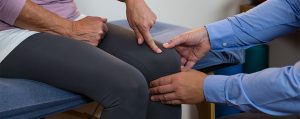PT Travel Hacks for Pain-free Vacation
Traveling should be fun and not a precursor to injury. Use these tips to help make your next trip as pain-free as possible.
Golf Swing Stretches/Exercises to Reduce Arm and Shoulder Soreness
You’ve made the turn. You have a score that says you might just be having the round of your life. A few practice swings and the 10th fairway will be your chipping mat. Driver’s out of the bag, glove on, and the ball teed up nice and high. You start shaking off the memories of the chunked sand shot on the last hole and set up to take a few practice swings. The first one feels good. You step up and swing for the fences. In a moment, your shoulder hurts, your face cringes, and you cleared that fence right into the HOA president’s pool.
3 Exercises to Perform After An Ankle Sprain
Ankle sprains are an extremely common lower extremity injury in both athletic and general populations. Ankle sprains account for up to 40% of lower extremity sports injuries1 and are one of the most common injuries to be seen in the emergency room2. Most ankle sprains occur when the ankle “rolls” inward, resulting in pain, swelling, loss of motion, and bruising around the ankle.
Ankle Strengthening Exercises to Try at Home/Work/Anywhere
The foot and ankle complex are the powerhouse of the body. It is the first thing touching the ground and absorbing everything the body does. While the foot and ankle are very important structures for the body, they are also very complex. There are 26 bones, 30 joints, and more than 100 muscles, ligaments, and tendons that help to support the foot and ankle. Having a strong foot and ankle is essential for injury prevention. How can you increase the strength of your ankles on the fly? Try doing 3 sets of 10 repetitions of these 5 exercises on the go.
Static Stretches for Improved Flexibility
Are you dealing with tight muscles, or maybe you don’t feel very flexible? When used correctly, stretching can be a useful tool to address tight muscles and improve muscle flexibility. Recent studies have confirmed that performing low intensity stretches over a long period can improve flexibility. Let’s look at a handful of simple stretches you can do to improve tight muscles.
Top Areas to Foam Roll for Gymnasts
Warm-up and recovery are important parts of a workout routine that often get overlooked. A dynamic warm-up prepares the body prior to exercise; conversely, recovery or cooling down after exercise can help manage soreness. Active recovery is a great option to help manage normal muscle soreness symptoms after high-intensity workouts. It is normal to have muscle soreness after high- intensity exercise; this can last for several hours up to several days. Active recovery may help reduce muscle soreness and fatigue.
Do I Need to Stretch My Ankles?
If you have been inside a gym or physical therapy office, you may have heard the phrase “stretch your calves.” This phrase can mean so many different things to so many different people. Let’s take a few minutes to clear up the confusion, and ensure everyone gets the most out of their exercise routine.
How PT Can Help You Shake Your Frozen Shoulder
Adhesive capsulitis, or as it is more commonly referred to, frozen shoulder, is a severe and long-term problem. It affects 3-5% of the general population, women slightly more than men, typically between 40-60 years old, and is 4x more likely in people with diabetes. The cause of primary adhesive capsulitis is unknown, but secondary adhesive capsulitis occurs when there is already known primary injury to the shoulder. However, the recovery process can be faster with physical therapy, and you can return to your previous full function. There are three phases of frozen shoulder: freezing, frozen, and thawing.

